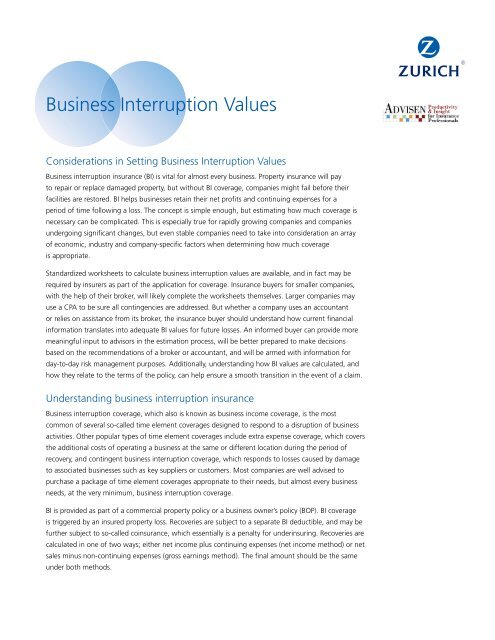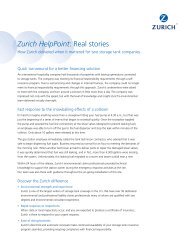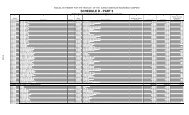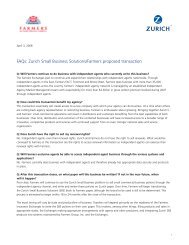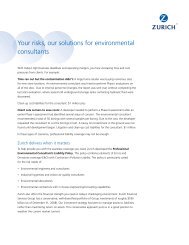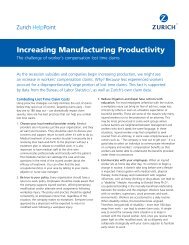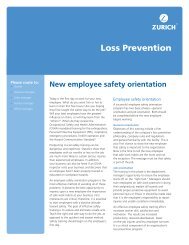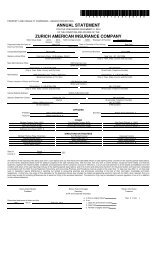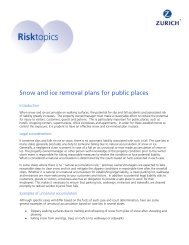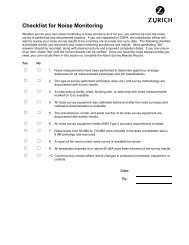Considerations in Setting Business Interruption Values - Zurich
Considerations in Setting Business Interruption Values - Zurich
Considerations in Setting Business Interruption Values - Zurich
- No tags were found...
Create successful ePaper yourself
Turn your PDF publications into a flip-book with our unique Google optimized e-Paper software.
Bus<strong>in</strong>ess <strong>Interruption</strong> <strong>Values</strong><strong>Considerations</strong> <strong>in</strong> Sett<strong>in</strong>g Bus<strong>in</strong>ess <strong>Interruption</strong> <strong>Values</strong>Bus<strong>in</strong>ess <strong>in</strong>terruption <strong>in</strong>surance (BI) is vital for almost every bus<strong>in</strong>ess. Property <strong>in</strong>surance will payto repair or replace damaged property, but without BI coverage, companies might fail before theirfacilities are restored. BI helps bus<strong>in</strong>esses reta<strong>in</strong> their net profits and cont<strong>in</strong>u<strong>in</strong>g expenses for aperiod of time follow<strong>in</strong>g a loss. The concept is simple enough, but estimat<strong>in</strong>g how much coverage isnecessary can be complicated. This is especially true for rapidly grow<strong>in</strong>g companies and companiesundergo<strong>in</strong>g significant changes, but even stable companies need to take <strong>in</strong>to consideration an arrayof economic, <strong>in</strong>dustry and company-specific factors when determ<strong>in</strong><strong>in</strong>g how much coverageis appropriate.Standardized worksheets to calculate bus<strong>in</strong>ess <strong>in</strong>terruption values are available, and <strong>in</strong> fact may berequired by <strong>in</strong>surers as part of the application for coverage. Insurance buyers for smaller companies,with the help of their broker, will likely complete the worksheets themselves. Larger companies mayuse a CPA to be sure all cont<strong>in</strong>gencies are addressed. But whether a company uses an accountantor relies on assistance from its broker, the <strong>in</strong>surance buyer should understand how current f<strong>in</strong>ancial<strong>in</strong>formation translates <strong>in</strong>to adequate BI values for future losses. An <strong>in</strong>formed buyer can provide moremean<strong>in</strong>gful <strong>in</strong>put to advisors <strong>in</strong> the estimation process, will be better prepared to make decisionsbased on the recommendations of a broker or accountant, and will be armed with <strong>in</strong>formation forday-to-day risk management purposes. Additionally, understand<strong>in</strong>g how BI values are calculated, andhow they relate to the terms of the policy, can help ensure a smooth transition <strong>in</strong> the event of a claim.Understand<strong>in</strong>g bus<strong>in</strong>ess <strong>in</strong>terruption <strong>in</strong>suranceBus<strong>in</strong>ess <strong>in</strong>terruption coverage, which also is known as bus<strong>in</strong>ess <strong>in</strong>come coverage, is the mostcommon of several so-called time element coverages designed to respond to a disruption of bus<strong>in</strong>essactivities. Other popular types of time element coverages <strong>in</strong>clude extra expense coverage, which coversthe additional costs of operat<strong>in</strong>g a bus<strong>in</strong>ess at the same or different location dur<strong>in</strong>g the period ofrecovery, and cont<strong>in</strong>gent bus<strong>in</strong>ess <strong>in</strong>terruption coverage, which responds to losses caused by damageto associated bus<strong>in</strong>esses such as key suppliers or customers. Most companies are well advised topurchase a package of time element coverages appropriate to their needs, but almost every bus<strong>in</strong>essneeds, at the very m<strong>in</strong>imum, bus<strong>in</strong>ess <strong>in</strong>terruption coverage.BI is provided as part of a commercial property policy or a bus<strong>in</strong>ess owner’s policy (BOP). BI coverageis triggered by an <strong>in</strong>sured property loss. Recoveries are subject to a separate BI deductible, and may befurther subject to so-called co<strong>in</strong>surance, which essentially is a penalty for under<strong>in</strong>sur<strong>in</strong>g. Recoveries arecalculated <strong>in</strong> one of two ways; either net <strong>in</strong>come plus cont<strong>in</strong>u<strong>in</strong>g expenses (net <strong>in</strong>come method) or netsales m<strong>in</strong>us non-cont<strong>in</strong>u<strong>in</strong>g expenses (gross earn<strong>in</strong>gs method). The f<strong>in</strong>al amount should be the sameunder both methods.
Determ<strong>in</strong><strong>in</strong>g appropriate BI valuesS<strong>in</strong>ce BI covers lost net profits and cont<strong>in</strong>u<strong>in</strong>g expenses after a major fire, a natural catastrophe, oranother <strong>in</strong>sured event, the goal <strong>in</strong> sett<strong>in</strong>g BI values is to conservatively estimate a company’s futurerevenues and expenses. The process can be relatively straightforward for small, stable companies,though all companies need to take <strong>in</strong>to account the impact of macroeconomic, legal and regulatoryfactors. Larger or more complex companies, and all companies that are grow<strong>in</strong>g or experienc<strong>in</strong>gmaterial changes <strong>in</strong> structure or strategy, need to consider a wide array of variables to be certa<strong>in</strong> thatthe calculated BI value is the best estimate of the company’s future f<strong>in</strong>ancial state.The follow<strong>in</strong>g questions will help buyers to understand some of the key considerations <strong>in</strong> sett<strong>in</strong>g BIvalues. They highlight common issues with both the <strong>in</strong>formation used <strong>in</strong> bus<strong>in</strong>ess <strong>in</strong>come worksheetsand the process of transform<strong>in</strong>g that <strong>in</strong>formation to the values used to determ<strong>in</strong>e the amount <strong>in</strong>suredand the BI premium.Bus<strong>in</strong>ess <strong>in</strong>come worksheet calculationsAlmost all bus<strong>in</strong>ess <strong>in</strong>come worksheets <strong>in</strong>clude current revenues and expenses, forecast changes <strong>in</strong>those revenues and expenses dur<strong>in</strong>g the follow<strong>in</strong>g 12 months, and adjust for certa<strong>in</strong> non-cont<strong>in</strong>u<strong>in</strong>gexpenses. The follow<strong>in</strong>g considerations should be kept <strong>in</strong> m<strong>in</strong>d when complet<strong>in</strong>g these worksheets.• Is the f<strong>in</strong>ancial <strong>in</strong>formation complete, accurate, and up to date?The start<strong>in</strong>g po<strong>in</strong>t for calculat<strong>in</strong>g BI values is revenues for the most recently completed twelvemonth f<strong>in</strong>ancial period. Most worksheets take a top-down or deductive approach to calculat<strong>in</strong>gthis value: annual net sales plus other earn<strong>in</strong>gs from bus<strong>in</strong>ess operations m<strong>in</strong>us certa<strong>in</strong> noncont<strong>in</strong>u<strong>in</strong>gexpenses. Often the <strong>in</strong>surance buyer will need to solicit the help of the account<strong>in</strong>g orf<strong>in</strong>ance department to get all the required <strong>in</strong>formation. To smooth the process and to assure all thenecessary <strong>in</strong>formation is as complete and timely as possible, <strong>in</strong>surance buyers should identify thedata elements needed to complete the worksheet and assemble the <strong>in</strong>formation well <strong>in</strong> advanceof apply<strong>in</strong>g for coverage. More complex companies may require <strong>in</strong>put from a number of differentbus<strong>in</strong>ess units.Us<strong>in</strong>g current <strong>in</strong>formation is important, especially as the economy recovers from the worstdownturn s<strong>in</strong>ce the Great Depression. However, companies vary <strong>in</strong> their ability (and will<strong>in</strong>gness) toproduce complete, accurate and timely f<strong>in</strong>ancial <strong>in</strong>formation on demand. If <strong>in</strong>surance buyers andtheir advisors need to use older or <strong>in</strong>complete <strong>in</strong>formation, it is important that they understandwhere gaps exist or where more current <strong>in</strong>formation, if it were available, would likely differ.Insurance buyers should keep <strong>in</strong> m<strong>in</strong>d that rapidly grow<strong>in</strong>g bus<strong>in</strong>esses may need to update BI valuesmore frequently than once a year as.• Have all the factors potentially <strong>in</strong>fluenc<strong>in</strong>g changes <strong>in</strong> the bus<strong>in</strong>ess over the next 12 months beentaken <strong>in</strong>to account and properly quantified?A critical factor <strong>in</strong> establish<strong>in</strong>g adequate BI values is a realistic assessment of how revenues andexpenses will change over the com<strong>in</strong>g year. Most companies have budgets that can be referencedto adjust revenues and expenses. However, if budgets are more than a few months old, chang<strong>in</strong>gconditions may already have dim<strong>in</strong>ished their relevance. Additionally, budgets may not take <strong>in</strong>toaccount important changes such as a proposed acquisition. Budgets also may discount the value offuture events that could have significant impact on revenues, such as the likelihood of clos<strong>in</strong>g largedeals still <strong>in</strong> the pipel<strong>in</strong>e.In addition to changes with<strong>in</strong> the company itself, external factors need to be taken <strong>in</strong>toconsideration. These <strong>in</strong>clude economic changes, the competitive landscape, factors that couldimpact suppliers or customers, and regulatory developments.
• Have expenses been properly identified and <strong>in</strong>corporated <strong>in</strong> the calculated BI value?BI covers net profits and cont<strong>in</strong>u<strong>in</strong>g expenses. Expenses that would not cont<strong>in</strong>ue as the companyrebuilds, and therefore are not <strong>in</strong>cluded <strong>in</strong> the settlement of a BI claim, could <strong>in</strong>clude:- Materials and supplies,- Services that would not cont<strong>in</strong>ue under contract,- Variable energy costsSo-called ord<strong>in</strong>ary payroll – payroll for other than managers and other essential employees directly<strong>in</strong>volved <strong>in</strong> rebuild<strong>in</strong>g the bus<strong>in</strong>ess – typically would not cont<strong>in</strong>ue. For bus<strong>in</strong>esses concerned aboutlos<strong>in</strong>g tra<strong>in</strong>ed employees while there is no work, ord<strong>in</strong>ary payroll coverage is available to cont<strong>in</strong>uepay<strong>in</strong>g salaries and benefits.Although non-cont<strong>in</strong>u<strong>in</strong>g expenses are not covered <strong>in</strong> claim settlements, most expenses, should be<strong>in</strong>cluded <strong>in</strong> the bus<strong>in</strong>ess <strong>in</strong>come worksheet and factored <strong>in</strong>to the BI value used to set limitsand premiums.• What factors could <strong>in</strong>fluence the time it could take for your company to recover after a major eventsuch as a large fire?The “period of restoration” is the period of time after a loss necessary to get the bus<strong>in</strong>ess openaga<strong>in</strong>. It can be a key factor <strong>in</strong> help<strong>in</strong>g to determ<strong>in</strong>e the appropriate amount of BI coverage: theselected period, expressed as a percentage of a full year, is multiplied times the 12-month projectednet profits and cont<strong>in</strong>u<strong>in</strong>g expenses to arrive at the <strong>in</strong>itial BI limit of <strong>in</strong>surance.There are no standard rules for determ<strong>in</strong><strong>in</strong>g duration, but buyers should keep <strong>in</strong> m<strong>in</strong>d that <strong>in</strong>the event of a large natural catastrophe such as an earthquake or hurricane, limitations on suchnecessities as labor, materials and <strong>in</strong>frastructure services can slow the recovery process. Zon<strong>in</strong>gchanges s<strong>in</strong>ce the orig<strong>in</strong>al facility was constructed could slow or derail plans to rebuild. On theother hand, some factors can accelerate recovery. Companies with well-conceived bus<strong>in</strong>esscont<strong>in</strong>uity plans <strong>in</strong> place, for example, most likely will recover more quickly from a loss.Other considerationsA number of factors can <strong>in</strong>fluence how severely a bus<strong>in</strong>ess will be impacted by a loss and how quicklyit will recover. In some cases other related time element coverages can be enormously valuable.• Follow<strong>in</strong>g a fire or other catastrophic occurrence, would your company be able to resume some orall of its operations at a temporary location?If a company can cont<strong>in</strong>ue to operate at an alternative location while the permanent location isrebuilt, the impact of the loss event can be significantly reduced. However, it is likely that additionalcosts will be <strong>in</strong>curred to procure, set up and operate the alternative location. Extra expensecoverage should be considered for this eventuality.• How much revenue would be lost if a major supplier suddenly was unavailable or if key customerswere unable to buy from your company?Companies rely<strong>in</strong>g on a few key suppliers could be <strong>in</strong> serious trouble if one or more of thosesuppliers were forced out of bus<strong>in</strong>ess by a fire or a natural catastrophe. Similarly, the loss of a keycustomer could be disastrous. Companies with vulnerabilities to key suppliers or customers shouldconsider cont<strong>in</strong>gent bus<strong>in</strong>ess <strong>in</strong>terruption coverage.
The importance of accurate BI valuesNeedless to say, no bus<strong>in</strong>ess wants to discover that, after experienc<strong>in</strong>g a devastat<strong>in</strong>g loss, it did notpurchase enough <strong>in</strong>surance to make it whole. With BI <strong>in</strong>surance, it is doubly important that companiesbuy the correct amount of coverage because of the co<strong>in</strong>surance clause found <strong>in</strong> most policies.Co<strong>in</strong>surance is essentially a penalty for under<strong>in</strong>sur<strong>in</strong>g. The rationale is that a higher premium wouldhave been necessary for the same amount of coverage if it was known that the policyholder did nothave the required BI limits.Insurance buyers cannot be expected to be experts <strong>in</strong> bus<strong>in</strong>ess <strong>in</strong>terruption <strong>in</strong>surance, but it isimportant that they are knowledgeable about the coverage and how BI values are calculated.Knowledgeable buyers can facilitate the process of determ<strong>in</strong><strong>in</strong>g adequate BI values for a company andwill be better prepared to work with their broker and underwriter to be sure they are well protected.Checklist of considerations <strong>in</strong> sett<strong>in</strong>g BI values• When is the last time you estimated the amount of bus<strong>in</strong>ess <strong>in</strong>terruption protection needed byyour company?• Does your bus<strong>in</strong>ess <strong>in</strong>come worksheet reflect the current value of all relevant sources of <strong>in</strong>comeand expense?• What <strong>in</strong>ternal and external factors will impact revenues and expenses over the next year?• Did you complete the worksheet properly, report<strong>in</strong>g current revenue projections andnon-cont<strong>in</strong>u<strong>in</strong>g expenses?• Does your estimate for the time it will take for your bus<strong>in</strong>ess to recover take <strong>in</strong>to accountfactors that could delay rebuild<strong>in</strong>g such as shortages of labor and materials follow<strong>in</strong>g anatural catastrophe?• Can your company resume operations at a temporary location?• Is your company vulnerable to the loss of key suppliers or customers?The <strong>in</strong>formation <strong>in</strong> this publication was compiled from sources believed to be reliable for <strong>in</strong>formational purposes only. All samplepolicies and procedures here<strong>in</strong> should serve as a guidel<strong>in</strong>e, which you can use to create your own policies and procedures. We trustthat you will customize these samples to reflect your own operations and believe that these samples may serve as a helpful platformfor this endeavor. Any and all <strong>in</strong>formation conta<strong>in</strong>ed here<strong>in</strong> is not <strong>in</strong>tended to constitute legal advice and accord<strong>in</strong>gly, you shouldconsult with your own attorneys when develop<strong>in</strong>g programs and policies. We do not guarantee the accuracy of this <strong>in</strong>formationor any results and further assume no liability <strong>in</strong> connection with this publication and sample policies and procedures, <strong>in</strong>clud<strong>in</strong>g any<strong>in</strong>formation, methods or safety suggestions conta<strong>in</strong>ed here<strong>in</strong>. Moreover, <strong>Zurich</strong> rem<strong>in</strong>ds you that this cannot be assumed to conta<strong>in</strong>every acceptable safety and compliance procedure or that additional procedures might not be appropriate under the circumstances.The subject matter of this publication is not tied to any specific <strong>in</strong>surance product nor will adopt<strong>in</strong>g these policies and proceduresensure coverage under any <strong>in</strong>surance policy.A1-19236-A (07/10) 10-2444<strong>Zurich</strong>1400 American Lane, Schaumburg, Ill<strong>in</strong>ois 60196-1056800 382 2150 www.zurichna.comThis is <strong>in</strong>tended as a general description of certa<strong>in</strong> types of <strong>in</strong>surance and services available toqualified customers through the companies of <strong>Zurich</strong> <strong>in</strong> North America. Your policy is the contract thatspecifically and fully describes your coverage. The description of the policy provisions gives a broadoverview of coverages and does not revise or amend the policy.Insurance coverages underwritten by member companies of <strong>Zurich</strong> <strong>in</strong> North America, <strong>in</strong>clud<strong>in</strong>g <strong>Zurich</strong>American Insurance Company. Certa<strong>in</strong> coverages not available <strong>in</strong> all states. Some coverages may bewritten on a nonadmitted basis through surplus l<strong>in</strong>es brokers.©2010 <strong>Zurich</strong> American Insurance Company


